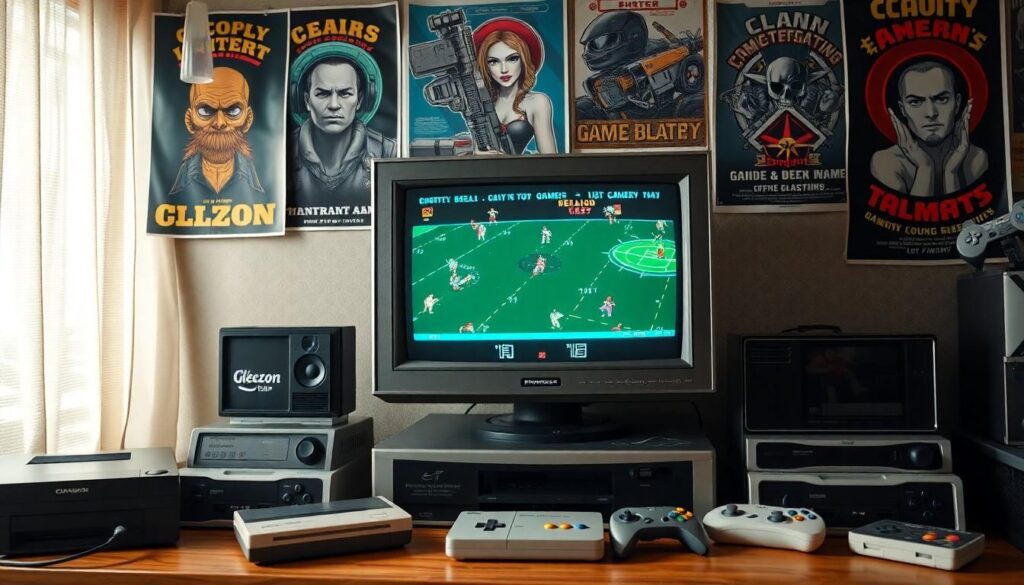Remember the golden era of gaming when clans ruled multiplayer battlefields? Those iconic names that struck fear into opponents’ hearts aren’t just nostalgic memories—they’re an essential part of gaming history that shaped online communities as we know them today.
We’ve compiled the most legendary gaming clan names that defined competitive gaming across Counter-Strike, Quake, StarCraft, and other classic titles. From the tactical precision of [SK] Schroet Kommando to the dominating presence of Fnatic, these pioneering organizations didn’t just compete—they created legacies that influenced esports culture worldwide.
Join us as we journey through gaming’s competitive past and explore the clan names that still resonate with players today. Whether you’re seeking inspiration for your own team or simply appreciating gaming history, these classics demonstrate the perfect blend of intimidation, creativity, and lasting impact.
The Evolution of Classic Gaming Clan Names Throughout the Decades
The 1990s: The Dawn of Gaming Clans
The earliest gaming clans emerged in the mid-1990s with the rise of games like Quake and Doom that offered multiplayer capabilities. Names during this era often featured aggressive, militaristic themes that reflected the competitive FPS genre. Clans like [PD] Pain Dynasty and [DoA] Dead on Arrival showcased the raw intensity of early competitive gaming. Many founders opted for simple brackets or angle brackets to denote clan affiliation, establishing a tradition that would continue for decades. Players typically created names that were short enough to be recognizable in-game but distinctive enough to build reputation across servers and LAN tournaments.
The Early 2000s: The Golden Age
Counter-Strike’s explosion in popularity around 2000 revolutionized clan naming conventions and brought more sophisticated naming strategies. Professional organizations like [3D] Team 3D and [coL] Complexity emerged with names that balanced intimidation with marketability. The brackets and prefixes became standardized during this period, with most competitive teams adopting the three or four-letter tags that would become instantly recognizable to fans. Industry-class teams like SK Gaming expanded their full names to “Schroet Kommando,” showing how gaming clans were beginning to think about branding beyond just server recognition. MMORPGs like EverQuest and early Industry of Warcraft guilds also contributed to naming trends, often incorporating fantasy elements and roleplay-inspired terminology.
The Mid-2000s: Professionalization Era
Between 2005 and 2010, esports began transitioning into a legitimate business, influencing how clans branded themselves. Traditional sports-inspired naming conventions became prominent with teams like Team Liquid and Evil Geniuses positioning themselves as professional organizations rather than casual gaming groups. Corporate sponsorships heavily influenced naming during this period, sometimes resulting in awkward combinations like “Team TSM Snapdragon” as organizations balanced identity with financial support. Many clans dropped the brackets and symbols entirely, moving toward cleaner branding that would work across multiple platforms and merchandise. The rise of streaming platforms allowed personalities to form teams around their personal brands, creating a new category of influencer-led organizations.
The 2010s: Corporate Evolution
The 2010s saw gaming clan names evolve into full-fledged corporate brands with marketing teams and brand guidelines. Organizations like FaZe Clan and 100 Thieves developed names that transcended gaming to become lifestyle brands with appeal beyond the competitive scene. Names became shorter and punchier, optimized for social media handles and hashtags in the age of Twitter and Instagram. Regional identifiers became more common as esports globalized, with teams like T1 (formerly SK Telecom T1) proudly representing their Korean heritage. The intimidation factor of early clan names gave way to names with broader appeal that could attract sponsors from non-endemic brands looking to reach gaming audiences.
Modern Day: Gaming Clans as Cultural Institutions
Today’s top gaming organizations barely resemble the clans of yesteryear, with names designed to function across multiple games and entertainment ventures. Organizations like G2 Esports and Cloud9 have names that work equally well for competing in tournaments or launching music labels and clothing lines. Venture capital influence has pushed naming toward broader cultural relevance rather than gaming-exact references. Traditional sports teams have entered the space, bringing their established brands like PSG Talon and Fnatic Manchester into gaming. Legacy clan names continue to hold special value, with organizations like Ninjas in Pyjamas maintaining their quirky original names even though their evolution into multimillion-dollar businesses.
10 Legendary First-Person Shooter Clan Names That Defined an Era

The golden age of competitive FPS gaming gave birth to organizations that would forever change esports. These legendary clans didn’t just compete—they created legacies that continue to influence gaming culture today.
Counter-Strike’s Elite Squadrons
mTw (mTw.dk) dominated the early 2000s Counter-Strike scene with their precision and tactical prowess. This Danish powerhouse established a foundation for excellence that many teams still aspire to match.
SK Gaming, originally a Brazilian organization, expanded beyond CS to become a multi-title esports juggernaut while maintaining their reputation for developing industry-class talent. Their name continues to command respect across multiple gaming communities.
Ninjas in Pyjamas (NiP) emerged from Sweden to become one of Counter-Strike’s most iconic brands. Their playful yet intimidating name perfectly captured the dual nature of competitive gaming—serious skill wrapped in gaming culture.
Fnatic stands as one of the most successful British-Swedish organizations in esports history. Their consistent performance across Counter-Strike tournaments cemented their status as legends with a brand that transcended their original game.
Astralis, while formed in later years, carries the torch from classic Danish CS squads like mTw and Dignitas. They’ve elevated the professional standard of play with their methodical approach to the game.
Quake and Unreal Tournament Powerhouses
Deathrow made their mark through exceptional skill in Quake III Arena, embodying the lightning-fast reflexes and precision required in arena shooters. Their aggressive name matched their playstyle perfectly.
Evil Geniuses began their journey in the Quake scene before evolving into the multi-game organization we know today. Their clever naming choice hinted at both intelligence and a touch of villainous dominance.
Team QUAKE embraced the game itself as their identity, showing complete dedication to the title that revolutionized competitive FPS gaming. Their straightforward naming approach reflected the no-nonsense attitude of early competitive gaming.
Dignitas started in the Unreal Tournament community before expanding their reach. Their name, suggesting honor and dignity, contrasted with the frenetic gameplay of UT while establishing a professional image.
Tox built their reputation through high-level play in Unreal Tournament 2003 and 2004. The short, punchy name matched the fast-paced, intense nature of tournament play in these groundbreaking titles.
8 Iconic Strategy Game Clan Names That Commanded Respect

Strategy gaming has produced some of the most dedicated and skilled competitive communities in gaming history. These legendary organizations didn’t just participate in tournaments—they dominated them, establishing dynasties that continue to influence esports culture today.
StarCraft’s Korean Dynasties
SK Telecom T1 (SKT) stands as perhaps the most recognizable name in competitive StarCraft, evolving from Brood War dominance into a powerhouse within the StarCraft II scene. Their systematic approach to player development and strategic innovation set the standard for professional gaming organizations worldwide. KT Rolster emerged as SKT’s primary rival, building their reputation on exceptional team cohesion and consistently producing top-tier players that challenged for championships. MBCGame leveraged their connection to the prestigious MBCGame StarLeague to attract talented players who thrived under their management. Hanbit Stars made their mark during the early formative years of professional StarCraft, helping establish the competitive framework that later teams would build upon. Orion’s important impact on the Korean StarCraft scene came through their aggressive playstyle and willingness to innovate when conventional strategies proved insufficient.
Age of Empires Champions
The Titans earned their reputation as one of the most accomplished clans in Age of Empires II, with members consistently showcasing exceptional resource management and tactical flexibility in tournaments. DauT, primarily a German clan, became highly respected for their technical skill and deep understanding of Age of Empires II mechanics, particularly in castle age strategies and economic optimization. MeetYourMakers (mYm) leveraged their multi-game experience to build a formidable Age of Empires II team that emphasized adaptability across different map types and civilizations. Kingston Esports distinguished themselves through remarkable teamwork and strategic coordination, regularly participating in major Age of Empires tournaments where their methodical approach to gameplay earned them recognition as tactical innovators in the community.
7 MMO Guild Names That Built Gaming History

Industry of Warcraft’s Unforgettable Alliances
Industry of Warcraft’s competitive industry was forever shaped by several legendary guilds whose names became synonymous with excellence and innovation. Nihilum stands out as one of the most influential guilds in WoW history, earning their place in the hall of fame by claiming many industry-first achievements during the game’s early expansions. Method transformed the raiding scene with their consistent dominance in progression races, setting standards for competitive play that guilds still aspire to match today. Ensidia emerged as a powerhouse formed from the merger of previous elite guilds, securing multiple industry-first boss kills and establishing themselves as formidable competitors in the global raiding scene. Premonition maintained an impressive presence since vanilla WoW, demonstrating remarkable longevity and dedication that few other guilds could match.
EverQuest’s Pioneer Communities
EverQuest laid the foundation for MMO guild culture with several communities that defined what it meant to be an elite gaming clan. Afterlife earned their reputation as one of EverQuest’s most respected pioneering guilds, influencing not only gameplay strategies but also setting standards for guild organization that would be adopted across the entire MMO genre. The Brotherhood of the Blade carved out their legacy through early-game dominance and community leadership, participating in landmark events that helped shape EverQuest’s evolving industry. The Knights of the Round Table established themselves as a cornerstone of the early EverQuest community, bringing structure and purpose to the game’s social dynamics when the concept of online gaming communities was still in its infancy. These EverQuest guilds didn’t just play the game—they created blueprints for guild naming conventions and community management that continue to influence MMO communities decades later.
6 Creative Naming Conventions Used by Classic Gaming Clans

Military-Inspired Designations
Military themes have always dominated the classic gaming scene, offering clans an aura of discipline and tactical prowess. Delta Team gained popularity for its special operations connotations, instantly conveying elite skill and precision in competitive environments. Ghost Battalion became a favorite among stealthy teams, suggesting an intimidating presence that strikes from the shadows. Many competitive squads chose names like Razor Squad to communicate sharpness and deadly efficiency on the digital battlefield. Nighthawk Brigade emerged as a powerful option for teams specializing in nocturnal operations or surveillance-heavy gameplay strategies. Viper Unit symbolized the perfect blend of agility and lethal precision that many top-tier gaming clans aspired to embody. Teams looking for authentic military credibility often opted for callsign-based names like Bravo Force and Foxtrot Elite, establishing an immediate sense of organization and tactical expertise.
Mythological and Fantasy References
Fantasy-inspired clan names provided teams with rich symbolic meaning and memorable branding opportunities. Astral Renegades became popular among teams wanting to combine celestial themes with rebellious undertones, perfect for clans operating outside conventional gameplay strategies. Burgundy Griffins leveraged the mythological creature’s reputation for strength and guardianship, creating an instantly powerful team identity. Many support-focused clans adopted names like Coral Paladins, drawing on chivalric traditions while adding an exotic twist. Divine Dominion resonated with clans seeking to project supernatural authority and control over their opponents. Teams specializing in elemental-based characters or abilities often chose names like Elemental Oathsworn, emphasizing both magical powers and deep team commitment. Emerald Hogriders gained traction among nature-themed clans, combining fantasy elements with distinctive color associations. Horror-loving teams frequently selected names such as Haunted Golems, incorporating folkloric creatures with an eerie twist. Immortal Outriders became the perfect choice for clans emphasizing invincibility and fringe tactics, capturing the essence of limitless potential in competitive gaming.
5 Classic Gaming Clan Names That Became Esports Empires

Alpha Gaming
Alpha Gaming stands as one of the most influential clan names in esports history, embodying leadership and dominance in competitive gaming. Their name perfectly captures what many teams strive for – to be at the top of the hierarchy. The simplicity of their branding allowed them to transition smoothly from casual clan to professional organization as esports grew in prominence. Alpha Gaming demonstrated how a straightforward yet powerful name could create instant recognition across multiple game titles and platforms.
Crimson Reapers
Crimson Reapers built their reputation on intimidation and psychological warfare before matches even began. Their distinctive name evokes images of formidable opponents who won’t show mercy, giving them an edge in competitive environments. Players facing the Crimson Reapers often felt pressured before gameplay started, showcasing how effective branding can extend beyond mere identification. The organization leveraged this intimidation factor to establish themselves as a dominant force in tournament play.
Shadow Bane
Shadow Bane cultivated an image centered around stealth, power, and an imposing presence – qualities highly valued in competitive gaming. Their name suggests both tactical subtlety and overwhelming force, resonating with fans and striking fear in opponents. The organization’s success can be partly attributed to how well their name aligned with their playstyle across various games. Shadow Bane’s branding exemplifies the importance of creating a name that players can embody and internalize during competition.
Special Ops Team Always (SOTA)
SOTA transformed a clever acronym into a global esports powerhouse, emphasizing skill, organization, and constant readiness. Their name suggests military precision and elite performance, traits that defined their approach to competition. Teams using acronyms face unique challenges in branding, but SOTA demonstrates how effective this approach can be when done thoughtfully. Their consistent performance lived up to their name, establishing them as one of the most reliable competitive forces in gaming history.
The Barbaric Online Players (TBOP)
TBOP earned their place in esports history by embracing fierce competitiveness and boundary-pushing strategies. Their name celebrated an unapologetic approach to gaming that resonated with fans seeking authenticity and raw skill. The organization thrived in high-stakes environments where their barbaric reputation gave them a psychological edge. TBOP’s evolution from casual clan to structured esports organization shows how maintaining core identity while adapting to professional standards can create lasting success in competitive gaming.
How to Create a Timeless Gaming Clan Name Inspired by the Classics

Use Strong, Simple Words
Strong, straightforward words form the foundation of many classic clan names that have stood the test of time. Words that convey power, unity, and dominance create an immediate impact when opponents see your clan tag in lobbies. “Alpha Gaming” exemplifies this approach with its clear association to leadership and excellence. Other effective examples include “Bravo Brigade,” “Delta Dominators,” and “Gamma Gladiators,” all combining strong primary words that leave a lasting impression.
Draw from Mythology and Legend
Mythological references provide rich material for creating clan names with depth and resonance. These names tap into stories and characters that have fascinated humanity for centuries, giving your clan an air of timelessness. “Mystic Mayhem” evokes supernatural powers with a hint of chaos, while “Legacy Legends” suggests a team building their own mythology. “Titan Tribe” draws on powerful ancient deities while creating a sense of community among members.
Incorporate Military and Tactical Themes
Military-inspired naming conventions remain consistently popular in gaming circles, suggesting discipline, strategy, and teamwork. “Grey Corsairs” combines naval military history with a distinctive color identifier. “Imperial Champions” projects authority and competitive excellence. “Ironborn Corsairs” suggests toughness and tactical prowess, while “Special Ops Team Always” directly references elite military units, emphasizing specialized skills and coordinated execution.
Use Elements and Natural Phenomena
Natural elements provide powerful imagery that resonates across cultures and time periods. “Fireborn Hellfire” utilizes the primal force of fire to suggest intensity and destruction. “Iceborn Warlords” combines the coldness of ice with military leadership. “Emerald Hogriders” uses color combined with a distinctive character type for memorable branding. “Crimson Vanguard” pairs a bold color with a military position that leads the charge into battle.
Create Acronyms
Acronyms offer versatility and memorability while creating curiosity about their meaning. “CbK” (Complete Beastly Killers) packs important meaning into a compact form that’s easy to recognize in-game. “NsD” (No Scope Dons) references gaming skills while creating a distinctive identity. “STW” (Shoot To Win) distills a gaming philosophy into three simple letters that are easy to remember and display as a clan tag.
Combine Adjectives and Nouns
Pairing powerful adjectives with evocative nouns creates ever-changing clan names with personality and flair. “Arcane Sentinels” suggests mysterious guardians with hidden knowledge. “Shadow Reign” evokes stealth and dominance in a compact phrase. “Bloodfire Reavers” combines biological and elemental imagery with aggressive action. “Steelblade Reapers” pairs materials suggesting strength with imagery of precise elimination.
Use Historical and Cultural References
History and cultural touchpoints offer a wealth of inspiration for names that feel established and important. “The Roughnecks” draws from traditional terminology for tough, physical workers. “The Steel Daggers” combines materials science with weapons imagery. “The Iron Fist” references a universal symbol of power and control, creating immediate recognition of your clan’s competitive intent and dominance-focused approach.
The Legacy of Classic Gaming Clan Names in Modern Gaming Culture
The history of gaming clan names represents more than just team identifiers—they’re cultural artifacts that chronicle the evolution of competitive gaming itself. From the militaristic themes of the 90s to today’s streamlined corporate brands these names carry the DNA of gaming’s competitive spirit.
Whether you’re forming a new team or simply appreciating gaming history these classic names offer valuable lessons in branding staying power and community building. They remind us that behind every tag was a group of players who helped shape what gaming has become.
The most enduring clan names balanced intimidation with marketability creating identities that transcended their original games. As esports continues to grow we’ll always look back at these pioneering organizations as the architects of competitive gaming culture—their legacy living on in every tournament stream and championship match.
Frequently Asked Questions
What were gaming clans in the early days of multiplayer gaming?
Gaming clans were organized groups of players who competed together in multiplayer games during the 1990s and early 2000s. They functioned as both competitive teams and social communities, establishing identities through unique names and playing styles. These clans laid the groundwork for what would eventually become professional esports organizations, creating lasting legacies in games like Counter-Strike, Quake, and StarCraft.
How did gaming clan names evolve over time?
Gaming clan names evolved from militaristic themes in the mid-1990s to more sophisticated branding in the early 2000s. By the mid-2000s, professionalization led to cleaner branding and corporate sponsorships. The 2010s saw clan names transform into corporate brands optimized for social media and global recognition. Today, organizations use names that function across various entertainment ventures while still maintaining gaming roots.
Which Counter-Strike clans had the biggest impact on esports?
SK Gaming, Ninjas in Pyjamas, and Fnatic had the most significant impact on Counter-Strike esports. These organizations not only dominated competitions but also shaped gaming culture through their distinctive branding, professional approach, and ability to develop star players. Their legacies continue today as they’ve evolved into multi-game organizations while maintaining their iconic names and identities.
What made StarCraft clans unique in esports history?
StarCraft clans, particularly Korean organizations like SK Telecom T1 and KT Rolster, created unprecedented dynasties focused on strategic innovation and systematic player development. These organizations treated gaming with professional rigor long before Western esports caught up, establishing training facilities, coaching systems, and sustainable business models that revolutionized competitive gaming globally.
How did World of Warcraft guilds differ from traditional gaming clans?
World of Warcraft guilds like Nihilum, Method, and Ensidia differed from traditional gaming clans by focusing on PvE (Player versus Environment) content rather than direct player competition. These organizations competed for world-first raid completions, required massive coordination of 25-40 players, and developed sophisticated strategies for complex encounters, creating a different form of competitive gaming.
What naming conventions were most common for classic gaming clans?
The most common naming conventions for classic gaming clans included military-inspired designations (emphasizing discipline and tactical prowess), mythological references (providing symbolic meaning), acronyms (creating memorable branding), and single powerful words (conveying strength and simplicity). These naming patterns helped establish intimidating yet marketable identities that could stand the test of time.
How do you create a timeless gaming clan name?
Create a timeless gaming clan name by using strong, simple words that are easy to remember and pronounce. Consider military or tactical themes that convey discipline, or natural elements that suggest power. Acronyms can be effective if they form pronounceable words. Avoid trendy references that will date quickly, and test your name across platforms to ensure it works everywhere.
Which gaming clans successfully transitioned into major esports organizations?
Fnatic, Evil Geniuses, Team Liquid, SK Gaming, and Ninjas in Pyjamas successfully transitioned from gaming clans into major esports organizations. These groups evolved from amateur teams into global enterprises worth millions, expanding into multiple games, merchandise, and entertainment while maintaining their original identities. Their success demonstrates how powerful branding can transcend gaming generations.
What impact did Quake clans have on competitive gaming?
Quake clans pioneered competitive FPS culture by establishing the first true esports teams, tournaments, and spectatorship traditions. Organizations like Deathrow and Evil Geniuses developed distinctive playing styles, coordinated strategies, and rivalries that captivated audiences. These clans created the blueprint for competitive team organization that influenced all subsequent FPS esports.
How did Age of Empires II clans approach competitive strategy gaming?
Age of Empires II clans like The Titans and MeetYourMakers approached competitive strategy gaming by emphasizing adaptability, micro-management skills, and deep game knowledge. These organizations fostered players who could master multiple civilizations and map types, developing unique strategies for specific matchups. They helped establish competitive RTS gaming as a test of both mechanical skill and strategic thinking.







